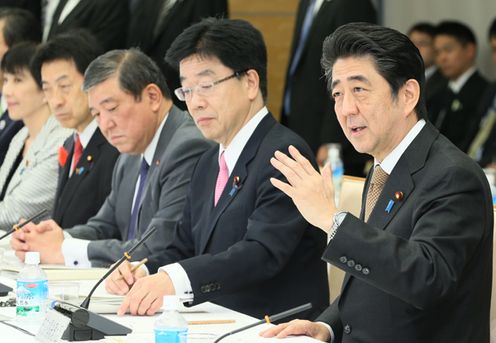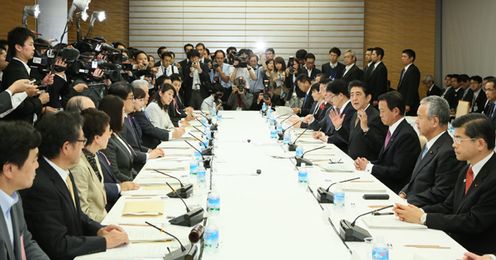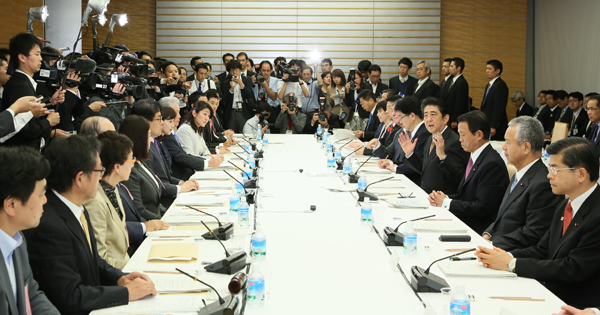Home > News > The Prime Minister in Action > October 2015 > National Council for Promoting the Dynamic Engagement of All Citizens
The Prime Minister in Action
National Council for Promoting the Dynamic Engagement of All Citizens
October 29, 2015

Photograph of the Prime Minister making a statement (1)

Photograph of the Prime Minister making a statement (1)

Photograph of the Prime Minister making a statement (2)
[Provisional Translation]
Prime Minister Shinzo Abe held the first meeting of the National Council for Promoting the Dynamic Engagement of All Citizens at the Prime Minister’s Office.
During the meeting, the Secretariat explained about the “new three arrows” policy, which was followed by statements from private-sector experts of the Council.
Based on the discussion, the Prime Minister said,
“Thank you for taking time out of your busy schedules today to attend the first meeting of the National Council for Promoting the Dynamic Engagement of All Citizens.
Before the inauguration of the second Abe administration, Japan was plagued by close to 20 years of deflation. This includes the first Abe administration. During that time, there was a great deal of discussion about how Japan could never escape deflation. In other words, I believe the greatest problem was the pessimism pervading Japan at the time, whereby people believed that nothing we could do would work.
This is why we introduced the three arrows policy, which was said to be a bold policy in some corners and reckless in others. Today, under this policy, we are almost at the point of escaping deflation.
The official ratio of job offers to job seekers for full-time employees is now at its highest point since this statistic was first recorded. Nevertheless, I have absolutely no intention of resting on my laurels. I believe our work is still only half complete. I hope to accelerate the current momentum and position Japan’s economy on an upward trajectory. Furthermore, with regard to the structural issue of an aging society and declining birthrate, although we have carried out various initiatives to date, we have yet to produce real results. However, now that we are regaining confidence in our ability to foster growth, I have decided that it is precisely the time to tackle this issue head on.
The benchmark for these efforts will be our initiative to maintain the population at 100 million people 50 years from now. If the current birthrate continues, the population of Japan will be just over 80 million 50 years from now, and 100 years from now it will be 40 million, which is one-third today’s population. This will directly lead to a decline in Japan’s competitiveness. Now is the time for the Cabinet to make concerted efforts toward realizing a society in which all one hundred million-plus citizens are each dynamically engaged.
Some people wonder what we mean by a society in which all one hundred million-plus citizens are each dynamically engaged. A little earlier Ms. Kikuchi provided an easy-to-understand explanation about this concept, but here I would like to share a personal anecdote. A poet by the name of Misuzu Kaneko was from my hometown of Nagato City in Yamaguchi Prefecture. She is famous for the poem ‘Bells, Birds and I Are All Different but All Wonderful.’ This embodies the idea that everyone is different, and I hope to create a society in which we can all have our own personalities, fulfill our own dreams, and find purpose in life. Furthermore, I hope to create a society where everyone can play an active role, including youth, the elderly, women, men, people with disabilities, people fighting an illness, and people who have experienced a major failure, by eliminating all policies that stand in the way of us achieving this.
It is based on this belief that I proposed the goal of realizing a society in which all one hundred million-plus citizens are each dynamically engaged.
To achieve this, during the second stage of Abenomics, the first arrow is a robust economy that gives rise to hope, which is a reinforcement of the “three arrows” that were in place before, and our target shall be achieving the largest GDP in postwar history of 600 trillion yen.
The second arrow will be dream-weaving childcare supports. Under this arrow we will aim to raise the birthrate to 1.8 children per woman, which is the level the public has indicated as desirable.
The third arrow will be social security that provides reassurance. Our goal with this arrow will be to reduce to zero the number of people who leave employment to provide nursing care.
We have set clear targets and will use the arrows as the means to achieve them.
Today marks the start of the National Council for Promoting the Dynamic Engagement of All Citizens. We have requested the participation of 15 private-sector experts who are active on the frontlines of a variety of fields, including social welfare, sports, academia, and business. Today, each of the private-sector members shared their views and thoughts. I hope that all of the private-sector experts participating in this Council will continue to proactively provide recommendations based on their wealth of experience and ideas.
First, with Minister Kato taking the lead, I would like this Council to identify measures that are urgently needed, by the end of November. At the same time, I would also like the Council to determine our basic stance, in preparation for compiling the Plan to Realize the Dynamic Engagement of All Citizens by next spring, which will serve as a concrete roadmap.
I would like you to compile measures that transcend boundaries between government ministries and agencies, and are not limited by conventional thinking. Since conventional ideas have not worked well, I would like to hear all-new proposals based on truly novel approaches. Thank you very much.”


